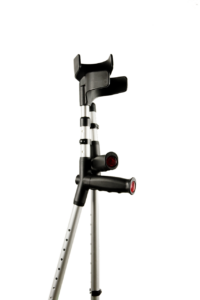VariWalk
Variable walking aid
Phase 1
Type of project: Prototype
Disability concerned: Motor disability
Topics: Autonomy, Health
Status: Completed
Getting up from a low seating surface is difficult for many people who rely on a walking aid. One of the main problems is the height of the handle when the user is seated. Our aim is to develop a walking aid that makes it easier to get up but is still lightweight and flexible to use.
In traditional walking aids (notably crutches and walking sticks), the length is adjusted so that the handle is at an ergonomic height when the user is standing/walking. However, when the user is sitting down and wants to stand up (transfer process), the handle is much too high. The user is then forced to adopt a very unfavourable arm position to lean on the handles. The necessary support force can therefore only be provided with difficulty by the arms and shoulders. An alternative is for the user to support themselves on the seat and only pick up the walking aids once they are standing, but this increases the risk of falling. Special lifting aids are a possible solution, but the person concerned is often unable to carry them on their own. As a last resort, the user must ask for help from a third party to get up safely.
It therefore appears that the incorrect height of the handle considerably complicates the standing-up process, increases the risk of falling and reduces the user’s independence. All this can have a drastic negative impact on their quality of life. The elderly and people with physical disabilities are particularly vulnerable.
The aim of the VariWalk project is therefore to develop an innovative walking aid that optimally supports the user not only when walking, but also when getting up. The aim is to reduce the risk of falls and injuries, and increase the activity, mobility and independence of users.
This has been achieved by equipping the walking aid (in the form of a crutch) with a rapid height adjustment system, which can be operated by the handle. This means that users can move the walking aid to a comfortable height when seated, lean against it, stand up and deploy the walking aid without having to let go of the handle.
Two functional prototypes have been successfully produced and subjected to initial testing. The next step is to test the prototypes as widely as possible. In addition to practical tests with the people concerned (via physiotherapists and rehabilitation clinics), quantitative measurements also need to be collected, for which we are planning a series of measurements on the Balgrist campus. We have applied for a second Innovation Booster for these measurements.
In particular, the aim is to measure the sequence of movement, the resulting joint loads and the subjective degree of difficulty experienced when standing up with conventional crutches, and to compare them with similar measurements of our solution.
The results will then be implemented through constructive adaptations to the product, before moving on to industrialisation and product authorisation.

